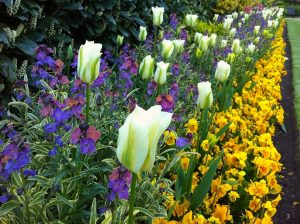 Spring is a beautiful word – /’sprɪŋ/ – even phonetically she’s a stunner, but she shies from her talents. Spring implies a sense of sudden energy and movement, a lively, upbeat quality. She’s a source of fresh water, of mineral and vitality. We pang for her familiar caress at night, on the soft and responsive mattresses that revive us so. No doubt about it, spring is a versatile and sassy mistress. Perhaps to the average Brit, however, the most enchanting thing about spring is the fact that she isn’t winter.
Spring is a beautiful word – /’sprɪŋ/ – even phonetically she’s a stunner, but she shies from her talents. Spring implies a sense of sudden energy and movement, a lively, upbeat quality. She’s a source of fresh water, of mineral and vitality. We pang for her familiar caress at night, on the soft and responsive mattresses that revive us so. No doubt about it, spring is a versatile and sassy mistress. Perhaps to the average Brit, however, the most enchanting thing about spring is the fact that she isn’t winter.
Spring, I put to you, is the hero of the fab four seasons. Summer, often the headline act and full of promise, casts a large shadow, but there is something magical and understated about spring. No other season can create such a swell of anticipation and deliver it so gracefully. Astronomically speaking the March equinox (19th to 21st) denotes the official unveiling of spring, but we are an impatient lot, us Brits – Londoners worse still – and celestial officialdom is for nerds. Come March 1st, come spring!
 For once we would embrace our Welsh brethren on this point, given that the Celts nabbed the very same day to celebrate their patron daffodil picker, St. David. Quite why the English opted for April 23rd to celebrate St. George is a matter of meteorological inconvenience, given that rain is all but guaranteed. Incidentally the Irish traditionally believe that spring starts on St. Brigid’s Day, February 1st, which is about as ridiculous as the historical credence given to the beer-soaked shenanigans of St. Patrick’s Day (March 17th; if you can’t beat ‘em, join ‘em). As for the Scots, the origins of their seasons, “cold” and “even colder still”, are less obvious.
For once we would embrace our Welsh brethren on this point, given that the Celts nabbed the very same day to celebrate their patron daffodil picker, St. David. Quite why the English opted for April 23rd to celebrate St. George is a matter of meteorological inconvenience, given that rain is all but guaranteed. Incidentally the Irish traditionally believe that spring starts on St. Brigid’s Day, February 1st, which is about as ridiculous as the historical credence given to the beer-soaked shenanigans of St. Patrick’s Day (March 17th; if you can’t beat ‘em, join ‘em). As for the Scots, the origins of their seasons, “cold” and “even colder still”, are less obvious.
Spring denotes a time when people remember how to socialise. Hibernation is over. The long dark winter, only briefly punctuated by the hearty distraction of Christmas and New Year is, finally, drawing to an end. New Year’s resolutions have long since been cast aside like unwanted stocking fillers and the uncompromising “dry” January did nothing but invoke reclusive paranoia. It’s catch-up time, drunk on the notion that going to buy the paper is no longer an “extreme” sport. Fold away the cashmere and stow away the duffel coats; springtime is in bloom.
So what is it specifically about March and April, given that spring stretches until 21st June (the Summer Solstice, any nerd will tell you) that gets us all giddy? Well January and February have been struck off, for a start, but it is more than just our first glimpse of sunshine; it is an attitude.
Fashions change, the winter collections turfed out like an overdressed gate-crasher, flinging the door wide open for blossoming floral designs and pastel coloured paisley prints. Green-fingered hopefuls start to believe their horticultural horoscopes and conjure up images of Pimms-fuelled garden parties. Entertainment schedules deflect their focus from the red-carpet banality of awards shows in an attempt to flog boastful summer blockbusters. Pubs frantically update their blackboards from “Escape the bitter cold with a cold bitter” to “We have a beer garden and don’t mind kids, anymore”. March and April, our cherished “Posh and Becks” of spring, bring us renewed energy and enthusiasm.
As if overnight, things don’t seem so bad, do they? Your boss seems less pedantic today. You avoided arriving (and leaving) the office under the cover of darkness. That after-work drink was less bitter tonight, and lighter in some way; more “bubbly” perhaps. You feel refreshed, revived. And inexplicably, everyone – no it’s not the prosecco talking – appears considerably easier on the eye.
 Spring is, in every way, about rejuvenation; a collective reawakening of the senses. This barrage of stimuli is nature’s way of congratulating us for our tenacity and endurance, for knuckling down and perfecting our stiff (and chapped) upper lip, which has persevered on our wind-torn faces for too many months. But no more shall we cower in the shadows, and take refuge in the shelter of flimsy shop-front awnings and overcrowded tube stations.
Spring is, in every way, about rejuvenation; a collective reawakening of the senses. This barrage of stimuli is nature’s way of congratulating us for our tenacity and endurance, for knuckling down and perfecting our stiff (and chapped) upper lip, which has persevered on our wind-torn faces for too many months. But no more shall we cower in the shadows, and take refuge in the shelter of flimsy shop-front awnings and overcrowded tube stations.
And maybe that is why, after all, British people talk so passionately about the weather. Cultural stereotyping has us forever bemoaning the weather as we daintily sip our Earl Grey, but perhaps this is unjust to a nation that simply likes a good natter (we’ve been dormant all winter), and is powerlessly governed by the climate. The calendar year, categorized into chunks of distinctive (mostly foul) weather forces us to prepare and adapt, in a way that seldom troubles more clement climes.
Spring in Brazil, to this point, given the relative consistency of the climate is arguably less significant. March itself represents the onset of autumn and is usually a bit of a damp squib. Daylight savings take effect a little earlier in these parts, meaning atmospheric calibration gets going a little sooner. But, Brazilians, given the less perceptible change, tend to remain less emotionally engaged in this process. The hot and sticky summer months of January and February, equally brutal in their own way, give way to a more comfortable temperature. With this welcome relent comes epic rain. The chuvas de março (March rains, which often pour well into April) are the Sampa version of April showers, but tropically torrential. Flash flooding and landslides are real threats, which is cruelly ironic given that much of the continent suffers extensive drought during the first trimester of the year.
As I type I am blinded by a typically brilliant São Paulo skyline. It’s the purest shade of baby blue imaginable and quite magnificent. But, as splendid as it is, I know that part of me is missing at this time, something inherent to my nature; the spring in my step that is March and April in London (isn’t she amazing, what other season can define itself so eloquently).
















